

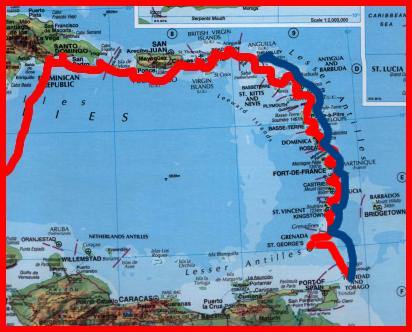
September started with nice 40-mile sail from Motril to Almerimar. Almerimar is a huge marina that claims to be "the ideal spot to leave your boat for the winter months". We checked everything out and had to agree. Almerimar is in the hot desert region of Espana (Spain). Even in the middle of the winter the climate is mild and dry. Our original plan was to winter in Barcelona. We checked with people about wintering there and the story was consistent; Barcelona is a lovely city but it is cold in the winter. It sometime snows in Barcelona. Living in the snow after four years in the tropics might be too much of a shock for us. We immediately made arrangements to winter "Reality" in Almerimar and then continued cruising eastward.
We had to motor from Almerimar to Almeria. The following day we had a nice sail around Cabo de Gata to Puerto Genoves. Genoves is just about the most southeastern corner of Spain. It is in the middle of a stretch of coast they call Coast Blanca. It's called Costa Blanca because of the white rocky cliffs that spot the area. Costa Blanca is rather pretty. It has been a nice change from the high rise condos of Costa del Sol. We spent a couple of wonderful nights in Genoves. It is a pretty bay that was a nature reserve. It had crystal clear water for swimming and beautiful white sand. It was lovely. It's one of the only bays we have seen in Spain that is completely natural....no development and very few boats.
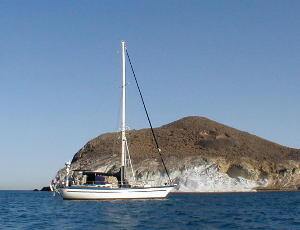
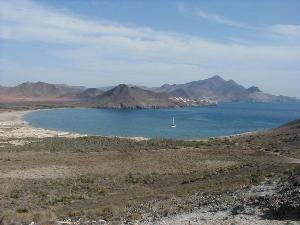
The high rugged Sierra Nevada Mountains surround Genoves bay. Espana's Sierra Nevada Mountains are quite different than our California homeland Sierra Nevada range. Espana's Sierra Nevada range rises steeply from the ocean. The mountains are barren and treeless. The peaks are sharp and jagged. The rock color varies in tones of brown and reds. The cliffs at the bay's headlands were a pretty backdrop of brilliant white rocks accented with formations of yellow, gray and black. We enjoyed walking the beach and hiking up the hills to overlook the bay.
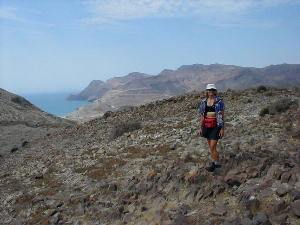
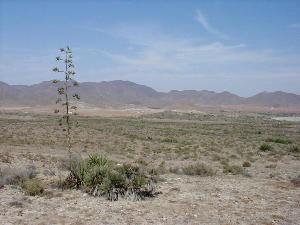
From Genoves we had a great 50-mile down wind sail to Aquilas. We set the sails in a wing and wing configuration and enjoyed zipping along at seven plus knots. Ocean sailing is all about these types of magically days. The memory of a delightful sail can make even the most ugly day slogging through rough seas seem bearable.
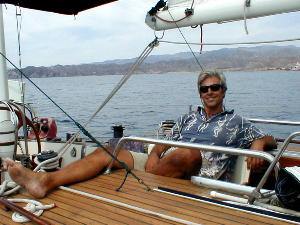
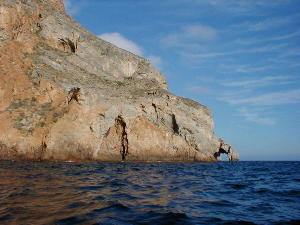
Aquilas is a nice town. It is not a tourist town, just a local working town. We spent a day. The next day we continued on in light breezes to a tiny little bay named "Cala Cerrado". Cala Cerrado was a perfectly round bay just big enough to anchor one boat! We squeezed in and had the bay all to ourselves for two days. It was a lovely spot.
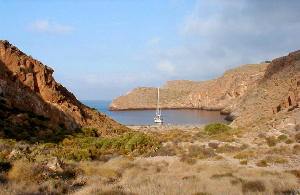
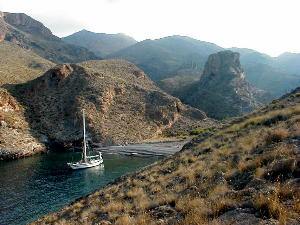
This section of the coast has steep cliffs that plunge directly into the sea. The mountain and rock formations are very colorful. The cliffs are bright orange, yellow, white and are full of caves. Because of the rugged mountains and cliffs there are no road along the coast. It was a refreshing change to have miles of coastline with no signs of civilization. We hiked up the steep hills and enjoying the views. The water was crystal clear and much warmer so we enjoyed snorkeling for the first time in the Med. We spent several days enjoying the natural beauty of this area.
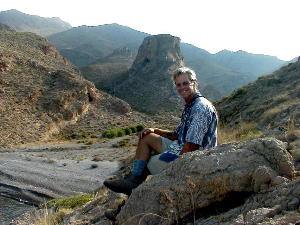
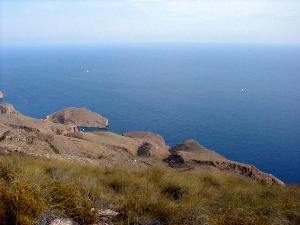
We anchored at several other places along this lovely part of the coast. We enjoyed snorkeling and hiking daily. While sailing and hiking we came across lots of old Moorish rock towers (lookouts) still in perfect condition. The Moores built the towers so strong that time has not eroded them. We would see these towers in the most out of the way places with no signs of an old town or settlement nearby. Just towers high on the tops of the hills and cliffs. The whole coastline was dotted with these towers. We saw perhaps 50! They were fascinating. We finally figured it out. The towers were spaced on the hilltops within line of sight to each other. From one tower you could always just see the next tower in both directions along the coast. We realized that this was the Moorish strongholds communication system. They covered hundreds of miles of coastline. They must have had a system of signaling to warn of an enemy approaching. By passing the signal on down the line they could warn distant towns of approaching danger perhaps days in advance...very cleaver.
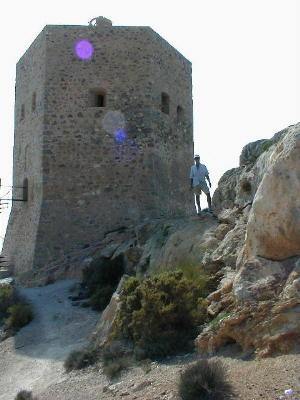
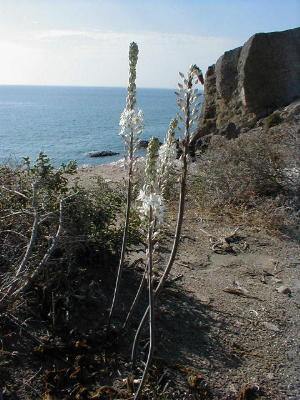
The end of September was rapidly approaching and we needed to start heading back to our winter marina. We needed to get Reality safely tucked away. We had big plans for our month long "European Road Trip".
We took a week to hop our way back to the marina. We stopped at the nice places we had found along the way. There are some very pretty spots in southern Espana (Spain) to our surprise it is mostly barren. In comparison, Espana southern coast makes Mexico's Baja coast look lush. At least Baja had lots of different kinds of cactus; here nothing seems to grow naturally. They do grow lot of produce in southern Espana. But it is all under plastic in hothouses! Plastic as far as the eye can see. There are hundreds of miles of hothouses. They must grow the vegetables under plastic to retain water from just evaporating away in the summer. In the winter the hothouses allow them to grow "summer" type vegetables; tomatoes, beans, melons, etc. They say all the winter vegetables for Europe are grown in southern Espana. Our new winter home is surrounded by vegetables under plastic. An interesting site indeed...
We arrived back to Marina Almerimar and tucked Reality away in preparation for our road trip.